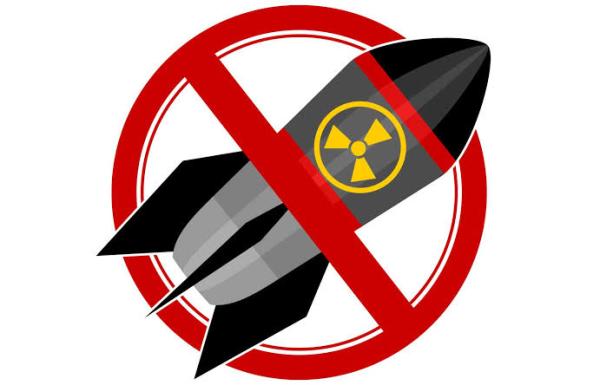
Globally, 26th September is set aside to celebrate International Day for the Total Elimination of Nuclear Weapons. A nuclear weapon is an explosive device that derives its destructive force from nuclear reactions, either fission or a combination of fission and fusion reactions, producing a nuclear explosion. Both bomb types release large quantities of energy from relatively small amounts of matter.
Nuclear weapons destroyed entire cities and also killed most of their people. It also produces ionizing radiation, which has long-term health consequences, such as cancer and genetic damage, kills or sickens those exposed, and contaminates the environment.
J. Robert Oppenheimer, an American theoretical physicist, and other scientists from the United States developed the first nuclear weapons. The world's first nuclear weapon’s explosion occurred on July 16, 1945, in New Mexico, when the United States tested its first nuclear bomb.
On August 6, 1945, the United States dropped nuclear weapon on the Japanese city of Hiroshima. It killed or wounded nearly 130,000 people. Three days later, the United States bombed Nagasaki. Of the 286,000 people living there at the time of the blast, 74,000 were killed and another 75,000 sustained severe injuries. Japan agreed to an unconditional surrender on August 14, 1945; it also resulted in the end of the World War II.
In subsequent years, the United States, the Soviet Union and Great Britain conducted several nuclear weapons tests. In 1954, President Jawaharlal Nehru of India called for a ban on nuclear testing. It was the first large-scale initiative to ban using nuclear technology for mass destruction.
In 1958, nearly 10,000 scientists presented to the United Nations’ Secretary-General, Dag Hammarskjold, a petition that begged, “We deem it imperative that immediate action be taken to effect an international agreement to stop testing of all nuclear weapons.”
Meanwhile, France exploded its first nuclear device in 1960 and China entered the "nuclear arms’ club" in October 1964 when it conducted its first test. In 1974, India conducted its first nuclear test: a subterranean explosion of a nuclear device (not weapon). India declared it to be a "peaceful" test, but it announced to the world that India had the scientific know-how to build a bomb.
Achieving global nuclear disarmament is one of the oldest goals of the United Nations. It was the subject of the General Assembly’s first resolution in 1946, which established the Atomic Energy Commission (dissolved in 1952), with a mandate to make specific proposals for the control of nuclear energy and the elimination of atomic weapons and all other major weapons adaptable to mass destruction. The United Nations has been at the forefront of many major diplomatic efforts to advance nuclear disarmament.
In 1959, the General Assembly endorsed the objective of general and complete disarmament. In 1978, the first Special Session of the General Assembly Devoted to Disarmament further recognized that nuclear disarmament should be the priority objective in the field of disarmament. Every United Nations Secretary-General has actively promoted this goal.
Nevertheless, today around 12,705 nuclear weapons remain. Countries possessing such weapons have well-funded, long-term plans to modernize their nuclear arsenals. More than half of the world’s population still lives in countries that either have such weapons or are members of nuclear alliances. While the number of deployed nuclear weapons has appreciably declined since the height of the Cold War, not one nuclear weapon has been physically destroyed. In addition, no nuclear disarmament negotiations are currently underway.
About sixty countries signed a treaty to seek the ends of the nuclear arms race and promote disarmament on July 1, 1968. The treaty bars nuclear weapons states from propagating weapons to other states and prohibits states without nuclear weapons to develop or acquire nuclear arsenal. It permits the use of nuclear energy for peaceful purposes. It entered into force in 1970 and was extended indefinitely and unconditionally on May 11, 1995. At this time, the nine declared nuclear weapons states are the USA, Russia, UK, France, China, United Kingdom, Pakistan, India and Israel.
The nine declared nuclear weapon countries and twenty-six other countries have refused, till date, to sign the treaty. Instead, they also "endorsed" the possession and use of nuclear weapons by allowing the potential use of nuclear weapons on their behalf as part of defense alliances, including the North Atlantic Treaty Organisation (NATO) and the Collective Security Treaty Organisation (CSTO).
The twenty-six countries that joined the nine delclared nuclear weapon countries were; Albania, Armenia, Australia, Belarus, Belgium, Bulgaria, Canada, Croatia, Czech, Denmark, Estonia, Germany, Greece, Hungary, Iceland, Italy, Japan, Latvia, Lithuania, Luxembourg, Montenegro, the Netherlands, North Macedonia, Norway, Poland, Portugal, Romania, Slovakia, Slovenia, South Korea, Spain and Turkey.
The 51 countries that signed the treaty include Antigua and Barbuda, Austria, Bangladesh, Belize, Benin, Bolivia, Botswana, Cook Islands, Costa Rica, Cuba, Dominica, Ecuador, El Salvador, Fiji, Gambia, Guyana, Holy See, Honduras, Ireland, Jamaica, Kazakhstan, Kiribati, Lao People's Democratic Republic, Lesotho, Malaysia, Maldives, Malta, Mexico, Namibia, Nauru, New Zealand, Nicaragua, Nigeria, Niue, Palau, Palestine, Panama, Paraguay, Saint Kitts and Nevis, Saint Lucia, Saint Vincent and the Grenadines, Samoa, San Marino, South Africa, Thailand, Trinidad and Tobago, Tuvalu, Uruguay, Vanuatu, Venezuela, Viet Nam.
The UN observes every September 26 as a day to celebrate International Day for the Total Elimination of Nuclear Weapons. This day provides an occasion for the world community to reaffirm its commitment to global nuclear disarmament as a priority. It provides an opportunity to educate the public—and their leaders—about the real benefits of eliminating such weapons, and the social and economic costs of perpetuating them. Commemorating this day at the United Nations is especially important, given its universal membership and its long experience in grappling with nuclear disarmament issues. It is the right place to address one of humanity’s greatest challenges; achieving the peace and security of a world without nuclear weapons.
In accordance with the General Assembly’s resolution 68/32 and subsequent resolutions, the purpose of the International Day is to further the objective of the total elimination of nuclear weapons through enhancing public awareness and education about the threat posed to humanity by nuclear weapons and the necessity for their total elimination. In so doing, it is hoped that these activities will help to mobilize new international efforts towards achieving the common goal of a nuclear-weapon-free world.
The General Assembly declared the International Day in December 2013, in its resolution 68/32, as a follow-up to the high-level meeting of the General Assembly on nuclear disarmament held on 26 September 2013, in New York. This was the latest in a series of efforts by the General Assembly to raise public awareness and to seek deeper engagement on nuclear disarmament matters. In 2009, the General Assembly had declared 29 August as the International Day against Nuclear Tests (resolution 64/35).
In resolution 68/32, the General Assembly called for the “urgent commencement of negotiations in the Conference on Disarmament of a comprehensive convention on nuclear weapons to prohibit their possession, development, production, acquisition, testing, stockpiling, transfer and use or threat of use, and to provide for their destruction.”
In 2014, in its resolution 69/58, the General Assembly further expressed its desire to commemorate the Day, and requested the Secretary-General and the President of the General Assembly to make all arrangements necessary to commemorate and promote it, including by convening an annual meeting of the Assembly to commemorate the International Day and to provide a platform for the promotion of these activities. The General Assembly repeated these requests and call-in subsequent years in its resolutions 70/34, 71/71, 72/251, 73/40, 74/54, 75/45, and 76/36.
The International Day for the Total Elimination of Nuclear Weapons has been observed annually since 2014. Pursuant to the resolutions of the General Assembly, Member States, the United Nations system and civil society, including non-governmental organizations, academia, parliamentarians, the mass media and individuals are encouraged to commemorate and promote the International Day through enhancing public awareness and education about the threat posed to humanity by nuclear weapons and the necessity for their total elimination.
To observe the International Day, the United Nations is supporting events both in New York and Geneva. United Nations Information Centres around the world are encouraged to raise awareness to the observance of International Day for the Total Elimination of Nuclear Weapons.





















